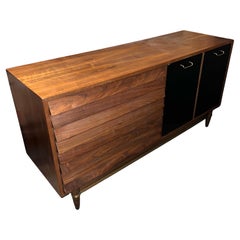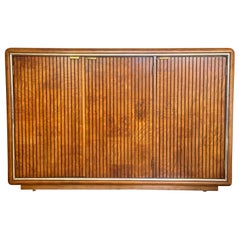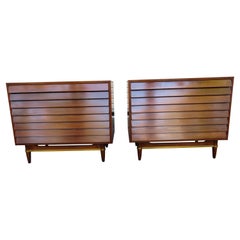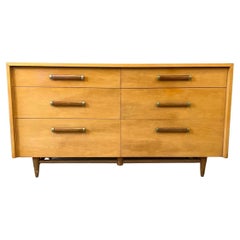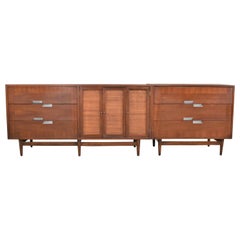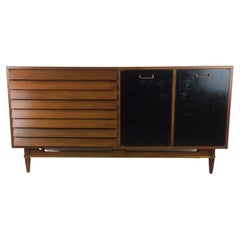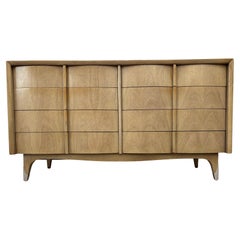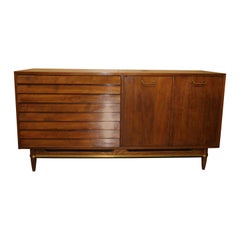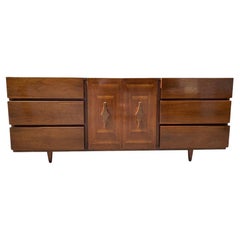American of Martinsville Credenzas
American of Martinsville is today revered as one of the finest manufacturers of mid-century modern furniture in the United States, but its beginnings were unexpectedly humble.
Well ahead of the Civil War, tobacco was a cash crop in places such as Virginia, and the plant was grown with frequency on farms in Martinsville and elsewhere. In the early 1900s, the business around tobacco was changing and the R.J. Reynolds Tobacco Company was expanding nationally, buying any Virginia factories in reach.
Former tobacco producers Ancil Witten and Charles Keesee turned away from the business in 1906 and, with merely $30,000 in capital (and the support of local business leaders), began to manufacture bedroom furniture under the name American Furniture Company.
In the 1920s, American Furniture Company expanded its offerings from bedroom furnishings. Alongside tallboy dressers and nightstands, Witten and Keesee’s outfit began to offer a range of dining-room sets to the discerning customer. By the 1950s, the name had been changed to American of Martinsville and the brand had gained a reputation for exquisite craftsmanship as well as its variety of furniture styles (Hollywood Regency, chinoiserie).
Mass-marketed furniture meant big business in the postwar years and throughout the 20th century in Virginia, and factories owned by companies like Bassett Furniture and American of Martinsville remained busy as suburbanites bought furniture to fill the homes they were moving into.
It isn’t difficult to spot American of Martinsville’s sturdy, solid designs — the lacquered walnut nightstands, mahogany coffee tables and credenzas have long earned the admiration of mid-century modernism enthusiasts. The company’s high profile also owes to prominent attributes that distinguish its well-made vintage furniture, such as the use of wooden slats — inspired by Scandinavian modernism — on hutches and cabinet doors, the famous brass x’s inlaid on the tops of tables and dressers and the stately stacked type of the American of Martinsville logo, which usually appears in drawer interiors. The stamp prominently features an eagle perched atop the lettering, its broad wings spread across the “American” portion.
Besides quality manufacturing, American of Martinsville is additionally recognized for having incorporated the trends of the day. Inspired by designers like George Nakashima and Paul Laszlo, the brand was also known for innovations with wood.
Merton Gershun was one of the company’s most prolific designers, and he was responsible for some of its most successful modern furniture lines using the richer, darker woods that would become emblematic of mid-century furniture. Gershun’s most popular line was reportedly Dania, with its sleek walnut credenzas fitted with stylish brass accents and large drawers. Today, American of Martinsville specializes in furniture for the healthcare and hospitality industries.
Shop a wide selection of vintage American of Martinsville sideboards, side tables and more on 1stDibs.
1950s American Mid-Century Modern Vintage American of Martinsville Credenzas
Brass
Mid-20th Century American Mid-Century Modern American of Martinsville Credenzas
Brass
1970s American Mid-Century Modern Vintage American of Martinsville Credenzas
Brass
1960s American Mid-Century Modern Vintage American of Martinsville Credenzas
Brass
1950s American Mid-Century Modern Vintage American of Martinsville Credenzas
Brass
Mid-20th Century American Mid-Century Modern American of Martinsville Credenzas
Aluminum
1950s American Mid-Century Modern Vintage American of Martinsville Credenzas
Brass
1960s American Mid-Century Modern Vintage American of Martinsville Credenzas
Brass
Late 20th Century American Chippendale American of Martinsville Credenzas
Metal
Mid-20th Century American Mid-Century Modern American of Martinsville Credenzas
Brass
1970s American Mid-Century Modern Vintage American of Martinsville Credenzas
Metal
1960s American Mid-Century Modern Vintage American of Martinsville Credenzas
Walnut
Mid-20th Century American Mid-Century Modern American of Martinsville Credenzas
Brass
1970s American Mid-Century Modern Vintage American of Martinsville Credenzas
Brass
1960s American Mid-Century Modern Vintage American of Martinsville Credenzas
Brass
1960s American Mid-Century Modern Vintage American of Martinsville Credenzas
Brass
20th Century American Mid-Century Modern American of Martinsville Credenzas
Brass
1960s American Mid-Century Modern Vintage American of Martinsville Credenzas
Walnut
Mid-20th Century American Art Deco American of Martinsville Credenzas
Glass, Burl
1960s American Mid-Century Modern Vintage American of Martinsville Credenzas
Brass
1960s Mid-Century Modern Vintage American of Martinsville Credenzas
Laminate
Mid-20th Century American Mid-Century Modern American of Martinsville Credenzas
Brass
20th Century American Hollywood Regency American of Martinsville Credenzas
Amethyst, Brass
20th Century American Mid-Century Modern American of Martinsville Credenzas
Brass
1950s American Mid-Century Modern Vintage American of Martinsville Credenzas
Wood
1970s American Mid-Century Modern Vintage American of Martinsville Credenzas
Chrome
Early 20th Century American Art Deco American of Martinsville Credenzas
Brass
Mid-20th Century American Mid-Century Modern American of Martinsville Credenzas
Brass
1960s American Mid-Century Modern Vintage American of Martinsville Credenzas
Wood
1960s American Mid-Century Modern Vintage American of Martinsville Credenzas
Walnut
Mid-20th Century American Mid-Century Modern American of Martinsville Credenzas
Metal
1960s American Brutalist Vintage American of Martinsville Credenzas
Walnut
1960s American Mid-Century Modern Vintage American of Martinsville Credenzas
Walnut
1970s American Mid-Century Modern Vintage American of Martinsville Credenzas
Walnut
20th Century American Mid-Century Modern American of Martinsville Credenzas
Oak
1970s American Mid-Century Modern Vintage American of Martinsville Credenzas
Metal
1960s American Mid-Century Modern Vintage American of Martinsville Credenzas
Brass
1950s American Mid-Century Modern Vintage American of Martinsville Credenzas
Burl
1960s American Mid-Century Modern Vintage American of Martinsville Credenzas
Walnut
1950s American Mid-Century Modern Vintage American of Martinsville Credenzas
Walnut
1970s American Mid-Century Modern Vintage American of Martinsville Credenzas
Walnut
1960s American Mid-Century Modern Vintage American of Martinsville Credenzas
Metal
1960s American Mid-Century Modern Vintage American of Martinsville Credenzas
Brass
1960s American Mid-Century Modern Vintage American of Martinsville Credenzas
Ebony, Walnut, Lacquer
1960s American Mid-Century Modern Vintage American of Martinsville Credenzas
Brass
Mid-20th Century American Mid-Century Modern American of Martinsville Credenzas
Walnut
1960s American Mid-Century Modern Vintage American of Martinsville Credenzas
Brass
1950s American Mid-Century Modern Vintage American of Martinsville Credenzas
Walnut
1960s Mid-Century Modern Vintage American of Martinsville Credenzas
Wood, Walnut
1960s American Mid-Century Modern Vintage American of Martinsville Credenzas
Walnut
20th Century American Mid-Century Modern American of Martinsville Credenzas
Brass
Antique and Vintage Credenzas for Sale on 1stDibs
Antique and vintage credenzas can add an understated touch of grace to your home. These long and sophisticated cabinet-style pieces of furniture can serve a variety of purposes, and they look great too.
In Italy, the credenza was originally a small side table used in religious services. Appropriately, credere in Italian means “to believe.” Credenzas were a place to not only set the food ready for meals, they were also a place to test and taste prepared food for poison before a dish was served to a member of the ruling class. Later, credenza was used to describe a type of versatile narrow side table, typically used for serving food in the home. In form, a credenza has much in common with a sideboard — in fact, the terms credenza and sideboard are used almost interchangeably today.
Credenzas usually have short legs or no legs at all, and can feature drawers and cabinets. And all kinds of iterations of the credenza have seen the light of day over the years, from ornately carved walnut credenzas originating in 16th-century Tuscany to the wealth of Art Deco credenzas — with their polished surfaces and geometric patterns — to the array of innovative modernist interpretations that American furniture maker Milo Baughman created for Directional and Thayer Coggin.
The credenza’s blend of style and functionality led to its widespread use in the 20th century. Mid-century modern credenzas are particularly popular — take a look at Danish furniture designer Arne Vodder’s classic Model 29, for instance, with its reversible sliding doors and elegant drawer pulls. Hans Wegner, another Danish modernist, produced strikingly minimalist credenzas in the 1950s and ’60s, as did influential designer Florence Knoll. Designers continue to explore new and exciting ways to update this long-loved furnishing.
Owing to its versatility and familiar low-profile form, the credenza remains popular in contemporary homes. Unlike many larger case pieces, credenzas can be placed under windows and in irregularly shaped rooms, such as foyers and entryways. This renders it a useful storage solution. In living rooms, for example, a credenza can be a sleek media console topped with plants and the rare art monographs you’ve been planning to show off. In homes with open floor plans, a credenza can help define multiple living spaces, making it ideal for loft apartments.
Browse a variety of antique, new and vintage credenzas on 1stDibs to find the perfect fit for your home today.
Creators Similar to American of Martinsville
- 1stDibs ExpertFebruary 22, 2021American of Martinsville, which was founded in 1906, is still in business. The company now manufactures furniture for hotel and healthcare industries.
- 1stDibs ExpertSeptember 23, 2024To identify American of Martinsville furniture, first look for the brand stamp, often found inside of a drawer, on the bottom of the piece or under a seat. The mark typically features the full brand name; some pieces also display an eagle logo. Another identifying characteristic of wood pieces made by the company are brass "X" inlays, often found on tabletops and the front of cabinet doors. Many mid-century American of Martinsville case goods also feature slatted or louvered doors. If you need help with the identification process, use the services of a certified appraiser or knowledgeable antique dealer. Shop a variety of American of Martinsville furniture on 1stDibs.
- 1stDibs ExpertFebruary 7, 2024How much an American of Martinsville dresser weighs can vary greatly. The dimensions and materials of the piece will determine its weight. Generally, highboy dressers will be the heaviest pieces produced by the American furniture maker due to their size. Shop a diverse assortment of American of Martinsville dressers on 1stDibs.
- 1stDibs ExpertMay 14, 2024The history of Martinsville furniture starts with the founding of the company in Martinsville, Virginia, in 1906 by Ancil Witten and Charles Keesee, a pair of former tobacco farmers. They launched their business with $30,000 in capital and began to manufacture bedroom furniture under the name American Furniture Company. In the 1920s, American Furniture Company expanded its offerings from bedroom furnishings with a range of dining room sets. By the 1950s, the company’s name had been changed to American of Martinsville, and it had gained a reputation for exquisite craftsmanship as well as a variety of furniture styles. Inspired by designers like George Nakashima and Paul László, the brand innovated with wood. Merton Gershun was one of the company's most prolific designers, and he was responsible for some of its most successful modern furniture lines using the richer, darker woods that would become emblematic of mid-century furniture. Gershun's most popular line was Dania, with its sleek walnut credenzas fitted with stylish brass accents and large drawers. Today, American of Martinsville specializes in furniture for the healthcare and hospitality industries. Find a variety of American of Martinsville furniture on 1stDibs.
- What is American oak?1 Answer1stDibs ExpertAugust 17, 2021American oak comes from oak trees that grow in America (as opposed to in Europe). While both are pale, American oaks have a slightly pink undertone and European oaks have a honey-hued undertone.
- What is Elgin American?1 Answer1stDibs ExpertApril 5, 2022Elgin American was an American brand known for producing watches, jewelry and compacts during the late 19th and early 20th centuries. The Illinois Watchcase Company owned it. In 1901, the company abandoned the Elgin name due to trademark infringement claims made by the Elgin National Watch Co. Find a selection of Elgin American art, jewelry and watches on 1stDibs.
- 1stDibs ExpertOctober 12, 2021A Native American artifact is any object that provides insight into the lives and history of native people in America. These items range from carved stone pipes, weapons for hunting, tools for cooking, pottery, jewelry and more. Find a collection of artifacts on 1stDibs today.
- What do Americans call a sofa?1 Answer1stDibs ExpertMarch 25, 2024What Americans call a sofa varies. Often, people living in the U.S. refer to an upholstered furnishing designed to hold more than one person as a couch. However, the word sofa is also commonly used in the U.S. On 1stDibs, find a diverse assortment of antique, vintage and contemporary sofas.
- What color is American walnut?1 Answer1stDibs ExpertOctober 12, 2021With respect to the actual wood, the outer layer of American walnut — the sapwood — has a creamy yellow-white color whereas the inner layer — the heartwood — ranges from a golden brown to dark chocolate brown color. In more descriptive words, the color of American walnut embodies the richness of chocolate mixed with slight undertones of red wine. On 1stDibs, find a variety of antique and vintage American walnut furniture.
- What is African American quilting?2 Answers1stDibs ExpertApril 5, 2022African American quilting has roots in history during slavery and was a way for African American women to bond. The quilts themselves tell stories of history, teach lessons and are beacons of hope. Shop a collection of African American quilts from some of the world’s top sellers on 1stDibs.1stDibs ExpertApril 5, 2022The history of African-American quilting stretches back almost as far as the beginning of the United States itself. The craft began with slave women quilting on plantations and after emancipation, the tradition of quilting continued. Today, there are many African American quilters who are inspired by a number of different quilting traditions. On 1stDibs, shop a collection of African-American quilts from some of the world’s top sellers.
- What is American cut glass?1 Answer1stDibs ExpertOctober 12, 2021American cut glass is a technique used for decorating glass. The period from 1771 to 1876 is considered the early period of American cut glass — later, cut glass was called Brilliant glass. This technique is associated with high labor costs and involves the work of skilled craftsmen — American cut glass is considered a luxury item and can be very valuable.
- Is sofa American or British?1 Answer1stDibs ExpertMay 30, 2024Sofa is both American and British. In the UK, sofa is the most commonly used term for an upholstered piece of furniture designed to seat two people or more. Americans use the word sofa as well. However, couch is the more popular name for sofas in the U.S. On 1stDibs, find a diverse assortment of antique, vintage and contemporary sofas.
- 1stDibs ExpertJanuary 27, 2025There was actually more than one famous American clockmaker. Many people refer to Eli Terry as the “father of mass-produced clocks in the U.S.,” as he introduced the concept of interchangeable parts that made large-scale production possible. Another well-known name in the history of American clock-making is Seth Thomas, who founded the Seth Thomas Clock Company in 1813. Brothers Aaron and Simon Willard are also important figures in the field, having developed banjo clocks and tall case clocks, respectively. Shop a variety of antique and vintage clocks on 1stDibs.
- 1stDibs ExpertNovember 22, 2024Yes, there is an American watch movement. In fact, there are multiple movements made in the USA. One is the Ameriquartz movement, a battery-driven quartz movement manufactured by Arizona-based maker Fine Timepiece Solutions for VAER watches. Another is the Caliber 1003 mechanical wind movement, created by Weis and produced in Nashville, Tennessee. Find a diverse assortment of watches on 1stDibs.
- 1stDibs ExpertApril 5, 2022In the Native American language of Powhatan spoken by the Algonquian indigenous people, moccasin refers to a hand-sewn suede bootie. Today, people may call any shoes that feature stitched round toes by the name. Shop a variety of moccasins on 1stDibs.
- 1stDibs ExpertApril 5, 2022There are a wide array of different dolls made by the various tribes of Native American peoples. Some of the most well-known are the kachinas made by the Navajo, Hopi and Pueblo peoples. Shop an array of Native American dolls on 1stDibs.
- 1stDibs ExpertApril 5, 2022What Native Americans used to produce baskets varied from tribe to tribe. Generally, craftsmen used whatever materials were readily available. In the Northeast, sweet grass was a common material, while pine needles and wicker are frequently found in baskets produced by tribes in the Southeast. Find a range of vintage and antique baskets on 1stDibs.
- 1stDibs ExpertNovember 22, 2024The oldest American watch brand that is still in operation is Waltham. When he founded the company in 1850, Aaron Lufkin Dennison revolutionized the industry by introducing the concept of replaceable watch components. This innovation allowed wristwatches and pocket watches to be produced in a fraction of the time it traditionally took to handcraft a watch with unique components. Find a selection of Waltham watches on 1stDibs.
- 1stDibs ExpertNovember 13, 2024To identify early American furniture, you can evaluate your piece on your own or seek the opinion of a certified appraiser or experienced antique dealer. Although many pieces from the Colonial era are unmarked, double-checking your furniture for signatures, stamps and labels is still a good first step. Using trusted online resources, you can research any markings to determine if the maker was active in America during the 16th and early 17th centuries. When identifying unmarked furniture, it's generally necessary to consider the style and details of the piece. Due to its handcrafted origins, early American furniture tends to have visible tool marks and irregularities in its carvings. Early American furnishings tended to be simple in style but often had one or two refined details, such as cabriole legs. Looking at images of authentic early American furniture can be helpful when making an identification. On 1stDibs, find a collection of 18th-century American furniture.
- 1stDibs ExpertApril 5, 2022What Native American drums are called varies by type. Ones designed to rest in the player's lap are hand drums, while instruments that hold water used primarily by the Iroquois and Yaqui are water drums. Large freestanding drums that produce loud percussive sounds are powwow drums. The Aztec and Hopi used foot drums. You'll find a range of Native American drums on 1stDibs.
- 1stDibs ExpertApril 5, 2022Native American slippers are called moccasins. Moccasins are characterized by their U-shaped puckered toe design and are crafted with various leathers such as sheepskin or buffalo. They may or may not be decorated with beading. Shop a collection of authentic moccasins from some of the world’s top sellers on 1stDibs.

